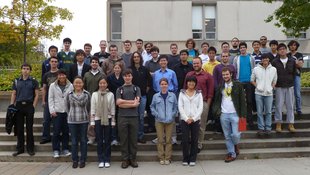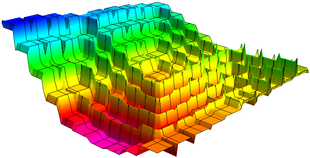10-327/Homework Assignment 2: Difference between revisions
No edit summary |
No edit summary |
||
| (21 intermediate revisions by 4 users not shown) | |||
| Line 1: | Line 1: | ||
{{10-327/Navigation}} |
{{10-327/Navigation}} |
||
{{In Preparation}} |
|||
===Reading=== |
|||
Read sections 17 through 21 in Munkres' textbook (Topology, 2nd edition). Remember that reading math isn't like reading a novel! If you read a novel and miss a few details most likely you'll still understand the novel. But if you miss a few details in a math text, often you'll miss everything that follows. So reading math takes reading and rereading and rerereading and a lot of thought about what you've read. Also, '''preread''' sections 22 through 24, just to get a feel for the future. |
|||
===Doing=== |
|||
Solve the following problems from Munkres' book, though submit only the <u>underlined</u> ones: Problems 6, <u>7</u>, 8, <u>13</u>, 14, 19abc, <u>19d</u>, 21 on pages 101-102, and problems <u>7a</u>, 7b, <u>8</u>, 9ab, <u>9c</u>, <u>13</u> on pages 111-112. |
|||
===Due date=== |
|||
This assignment is due at the end of class on Thursday, October 7, 2010. |
|||
===Suggestions for Good Deeds=== |
===Suggestions for Good Deeds=== |
||
Annotate our Monday videos (starting with {{10-327/vp|0927}}) in a manner similar to (say) {{dbnvp link|AKT-090910-1|AKT-090910-1}}, and/or add links to the blackboard shots, in a manner similar to {{dbnvp link|Alekseev-1006-1|Alekseev-1006-1}}. |
Annotate our Monday videos (starting with {{10-327/vp|0927}}) in a manner similar to (say) {{dbnvp link|AKT-090910-1|AKT-090910-1}}, and/or add links to the blackboard shots, in a manner similar to {{dbnvp link|Alekseev-1006-1|Alekseev-1006-1}}. Also, make ''constructive'' suggestions to me, {{Dror}} and / or the videographer, Qian (Sindy) Li, on how to improve the videos and / or the software used to display them. Note that "constructive" means also, "something that can be implemented relatively easily in the real world, given limited resources". |
||
{{Template:10-327:Dror/Students Divider}} |
|||
===Remark on the Due Date=== |
|||
*Dear Professor Bar-Natan, October 5 seems like a Tuesday. Do you mean October 7, 2010? Thanks! [[User:Fzhao|Fzhao]] 23:42, 30 September 2010 (EDT)Frank |
|||
**I stand corrected. [[User:Drorbn|Drorbn]] 06:33, 1 October 2010 (EDT) |
|||
===Questions=== |
|||
*Hi, I have a quick question. In the last question on the assignment that is being marked, what does it mean for one function to "uniquely determine" another. Sorry, I have just never heard that terminology before. - Jdw |
|||
** It means that any two functions with the property stated in the question are actually the same. [[User:Drorbn|Drorbn]] 07:19, 2 October 2010 (EDT) |
|||
*[[User:Xwbdsb|Xwbdsb]] 00:39, 2 October 2010 (EDT) I have a question about problem 13 on page 101. What does <math>x\times x</math> mean when <math>x</math> is an element in <math>X</math>? Does the author mean the ordered pair <math>(x,x)</math>? And we assume that we put product topology on <math>X \times X</math>? -Kai |
|||
** Yes and yes. [[User:Drorbn|Drorbn]] 07:19, 2 October 2010 (EDT) |
|||
*** I found a way to approach this problem but I am not sure about the technicality. <math>X \times X</math> is Hausdorff. We take any point in <math>\Delta</math> complement. So we can separate it from any point in <math>\Delta</math>. But to separate it from the entire <math>\Delta</math> we need to get the intersection of all its open nbds. Will that still be a valid open nbd? -Kai [[User:Xwbdsb|Xwbdsb]] 11:29, 2 October 2010 (EDT) |
|||
**** An arbitrary intersection of open sets is not necessarily open. This I'll say, but beyond this, it is your problem to solve. [[User:Drorbn|Drorbn]] 16:21, 2 October 2010 (EDT) |
|||
Latest revision as of 22:43, 11 November 2010
| ||||||||||||||||||||||||||||||||||||||||||||||||||||||||||||
Reading
Read sections 17 through 21 in Munkres' textbook (Topology, 2nd edition). Remember that reading math isn't like reading a novel! If you read a novel and miss a few details most likely you'll still understand the novel. But if you miss a few details in a math text, often you'll miss everything that follows. So reading math takes reading and rereading and rerereading and a lot of thought about what you've read. Also, preread sections 22 through 24, just to get a feel for the future.
Doing
Solve the following problems from Munkres' book, though submit only the underlined ones: Problems 6, 7, 8, 13, 14, 19abc, 19d, 21 on pages 101-102, and problems 7a, 7b, 8, 9ab, 9c, 13 on pages 111-112.
Due date
This assignment is due at the end of class on Thursday, October 7, 2010.
Suggestions for Good Deeds
Annotate our Monday videos (starting with Video: ![]() Topology-100927) in a manner similar to (say)
Topology-100927) in a manner similar to (say) ![]() AKT-090910-1, and/or add links to the blackboard shots, in a manner similar to
AKT-090910-1, and/or add links to the blackboard shots, in a manner similar to ![]() Alekseev-1006-1. Also, make constructive suggestions to me, Dror and / or the videographer, Qian (Sindy) Li, on how to improve the videos and / or the software used to display them. Note that "constructive" means also, "something that can be implemented relatively easily in the real world, given limited resources".
Alekseev-1006-1. Also, make constructive suggestions to me, Dror and / or the videographer, Qian (Sindy) Li, on how to improve the videos and / or the software used to display them. Note that "constructive" means also, "something that can be implemented relatively easily in the real world, given limited resources".
| Dror's notes above / Student's notes below |
Remark on the Due Date
- Dear Professor Bar-Natan, October 5 seems like a Tuesday. Do you mean October 7, 2010? Thanks! Fzhao 23:42, 30 September 2010 (EDT)Frank
- I stand corrected. Drorbn 06:33, 1 October 2010 (EDT)
Questions
- Hi, I have a quick question. In the last question on the assignment that is being marked, what does it mean for one function to "uniquely determine" another. Sorry, I have just never heard that terminology before. - Jdw
- It means that any two functions with the property stated in the question are actually the same. Drorbn 07:19, 2 October 2010 (EDT)
- Xwbdsb 00:39, 2 October 2010 (EDT) I have a question about problem 13 on page 101. What does mean when is an element in ? Does the author mean the ordered pair ? And we assume that we put product topology on ? -Kai
- Yes and yes. Drorbn 07:19, 2 October 2010 (EDT)
- I found a way to approach this problem but I am not sure about the technicality. is Hausdorff. We take any point in complement. So we can separate it from any point in . But to separate it from the entire we need to get the intersection of all its open nbds. Will that still be a valid open nbd? -Kai Xwbdsb 11:29, 2 October 2010 (EDT)
- An arbitrary intersection of open sets is not necessarily open. This I'll say, but beyond this, it is your problem to solve. Drorbn 16:21, 2 October 2010 (EDT)
- I found a way to approach this problem but I am not sure about the technicality. is Hausdorff. We take any point in complement. So we can separate it from any point in . But to separate it from the entire we need to get the intersection of all its open nbds. Will that still be a valid open nbd? -Kai Xwbdsb 11:29, 2 October 2010 (EDT)
- Yes and yes. Drorbn 07:19, 2 October 2010 (EDT)

![{\displaystyle [0,1]}](https://wikimedia.org/api/rest_v1/media/math/render/svg/738f7d23bb2d9642bab520020873cccbef49768d)









